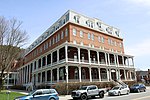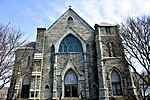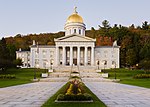Montpelier Historic District (Vermont)
Historic districts in Washington County, VermontHistoric districts on the National Register of Historic Places in VermontMontpelier, VermontNRHP infobox with nocatNational Register of Historic Places in Washington County, Vermont ... and 1 more
Use mdy dates from August 2023

The Montpelier Historic District encompasses much of the historic commercial and government district of Montpelier, the state capital of Vermont. The city center, focused on the confluence of the Winooski River with its North Branch, has been economically driven by state government since 1805, and had industry powered by the rivers. Its center reflects a diversity of 19th century architecture. In addition to the Vermont State House, the district includes The Pavilion, the commercial downtown area, and residential areas to the east and north. It was listed on the National Register of Historic Places in 1978, and enlarged in 1989 and 2018.
Excerpt from the Wikipedia article Montpelier Historic District (Vermont) (License: CC BY-SA 3.0, Authors, Images).Montpelier Historic District (Vermont)
Elm Street, Montpelier
Geographical coordinates (GPS) Address Nearby Places Show on map
Geographical coordinates (GPS)
| Latitude | Longitude |
|---|---|
| N 44.261388888889 ° | E -72.576944444444 ° |
Address
Elm Street
05602 Montpelier
Vermont, United States
Open on Google Maps






